Have you got a new tank, but you aren’t sure when to start adding fish? Here’s everything you need to know about when to add fish to your tank.
You can add new fish as soon as 24 hours after your tank is set up; however, it’s safer to wait 4-6 weeks until the tank is completely cycled before adding fish.
Now that you know when to add your fish, read on to discover how to safely add them to your tank.
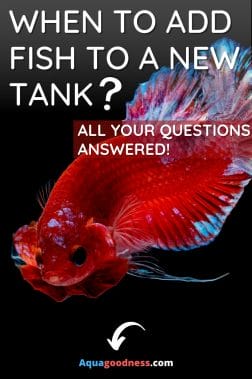
Table of Contents
When to Add New Fish
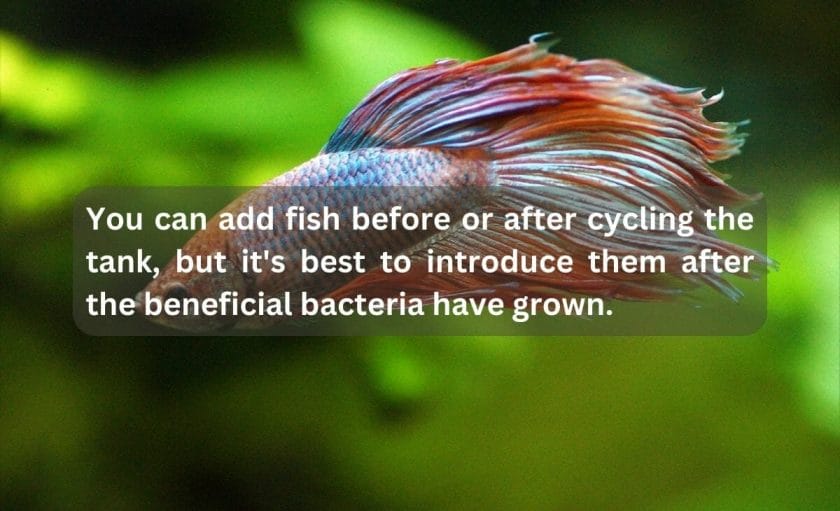
You might be eager to add new fish to your aquarium to fill it with life, but adding too many fish at once or adding fish too early can be detrimental and downright dangerous if you don’t know what you’re doing.
You can add fish either before or after cycling the tank, but it’s certainly more ideal to introduce your fish to their new environment once the beneficial bacteria have had time to develop.
Adding Fish During Cycling
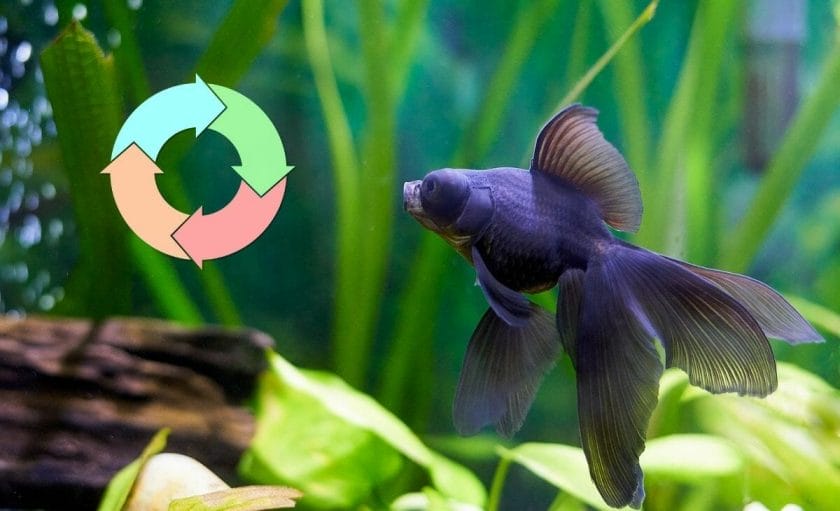
You can add fish as soon as 24 hours after you’ve set up your aquarium. You’ll want to at least wait 24 hours to allow time for the bacteria to start developing.
Introducing your fish too early can put significant strain on their health, and if you’re going to add fish to kickstart the cycling process, it helps to understand what you’re doing.
The nitrogen cycle is essential for the survival of your fish, and to ensure that harmful ammonia and nitrites are absent from a tank, the aquarium needs to take on a bacteria profile through a 4-6 week cycling process.
What You’ll Need to Get Started
Before you introduce fish to your new tank, make sure you have the following already installed:
- A suitably sized fish tank
- An adequate filter system and filter media
- An aquarium heater
- An air pump, check valve, and airline tubing
- Aquarium lights
In addition, you’ll want to have the following items on hand for maintenance down the line:
- Water conditioner and dechlorinator
- A siphon
- Aquarium water test kit
- Aquarium salt
- Fish food
- Fish net
Your tank should be fully set up before you introduce new fish to the cycle, and ideally, you should provide them plenty of places to hide via (non-sharp) aquarium decorations and plants.
Why You Should Add Live Plants
Live plants in particular are beneficial to maintaining ideal conditions in your tank and also contribute to making the tank a more natural-seeming environment for your fish.
Will Live Plants Help Cycle My Tank? (Answered)
What to Do When Adding Fish before Cycling

When you add fish to your uncycled tank, only add one or two, preferably fish that are hardy. These fish, or their biological waste specifically, produce byproducts of ammonia, which in turn prompt the growth of nitrites, then nitrates.
As the tank cycles, you will need to monitor the ammonia levels, conducting water changes or treating with a water conditioner such as SeaChem Prime.
Of course, while you can monitor conditions in your tank using a test kit, the cycling process always involves high concentrations of ammonia and nitrites, both extremely harmful to fish.
As such, introducing your fish 24 hours after setting up your new tanks can be done, but it’s not ideal at all.
Doing so can increase the risk of mortality in fish introduced to such deadly conditions, even long after they’ve survived the cycling process. Fish that survive can be permanently harmed, their quality of life greatly reduced due to gill burn and scarring.
Even after the cycling process is finished, the tank is by no means stable. In fact, the fishkeeping community groups several causes of death–poisoning, ammonia spikes, disease, stocking–under a generic term called new tank syndrome.
The biological filter and the resident bacterial colonies are not firmly established during the first few months after a tank is cycled, and at this point, the fish and the tank are at their most vulnerable to diseases, parasites, and harmful tank conditions.
Whether you’re doing a fish-in cycle or not, it’s always important to closely monitor your tank parameters using a test kit.
If you’ve made the mistake of buying fish before cycling your tank, then fish-in cycling is a viable, albeit unpleasant option.
Adding Fish after Cycling the Tank
Fishless cycling is always a better option, and it’s faster and safer than fish-in cycling. You can use a cycling kit, introduce ammonia to the tank via organic matter, or use filter media from a mature tank.
You’ll want to follow through the cycling process all the way through until your ammonia and nitrites have zeroed out before you add fish.
Once that happens, then the nitrogen cycle is completed, meaning that the ammonia and nitrites are met with enough beneficial bacteria to consume them so that they don’t negatively affect the fish.
Consider the following important signs that your tank is completely cycled:
- 0 ppm ammonia
- 0 ppm nitrites
- Presence of 20 ppm or less of nitrates
It’s important to remember that nitrates are somewhat toxic, too, and need to be removed from your water via regular water changes. Live plants can also help keep nitrates down and make great decorations for your tank, as well as improving the quality of life of your fish.
Once you’ve confirmed the presence of nitrates in your tank and zeroed out both ammonia and nitrites, it’s safe to add fish to your tank.
As a bonus tip, if you have a tank that’s already cycled or have a friend with a fully cycled tank, you can use pre-established filter media (yes, that yucky brown stuff is actually good!) or decorations to help cycle and stabilize your tank.
You can also just put a filter used in a mature tank in a new tank alongside a new filter to expedite the cycling process and help your new tank stabilize much more quickly.
How to Add Fish to Your Tank

Of course, it’s not enough that your tank is ready to accommodate fish. Your new aquarium tenants have spent the past half hour jostling around in a little plastic bag in the dark.
They’re probably not too thrilled about the prospect of facing the unknown in an entirely new tank environment and need to be acclimated properly into the new tank environment in order to avoid stressing them out too much.
Thankfully, there are a number of steps you can take to ensure the transition from the store to your aquarium is as stress-free as possible.
The following three steps are crucial in ensuring your fish are healthy and happy when introduced to a new tank:
- Stocking your tank sensibly
- Making a stress-free transfer
- Monitoring tank conditions
Stocking Your Tank Sensibly
First, let’s discuss the importance of stocking your tank appropriately. Remember that fish produce ammonia; thus, the more fish you have, the more ammonia your filter media is going to have to handle.
All these new fish contribute significantly to the bioload, which is the amount of waste organisms produce in an environment.
Some fish produce more waste than others, so it’s important to not only consider whether your tankmates get along with each other, but also how much they contribute to the waste in the tank.
On a newly cycled tank in particular, overloading the tank with a ton of new ammonia sources can cause ammonia spikes, leading to toxic and harmful conditions that affect both plant and animal life in your aquarium.
An overstocked tank also reduces the quality of life for its inhabitants, leading to heightened aggression in some species, stressed behavior, and increased susceptibility to illness, disease, and parasites.
To mitigate this risk, add only a few fish to get started. Over time, you can add more, but you should always consider the size tank you have weighed against the fish you want.
Making a Stress-Free Transfer
Now onto the mechanical process of introducing your fish to their new forever home.
When you bring your fish home from the store, you don’t know what kind of tank conditions they have been living in, so it’s always wise to help them acclimate to your tank’s conditions instead of just dumping them straight in.
Gradually introducing new fish to your aquarium conditions at a controlled rate reduces stress and ensures that the transfer is as smooth as possible.
Turn off the aquarium lights, as well as any bright lights in your home, since these can induce light-exposure shock in some more sensitive fish, as well as distress.
The Floating Method of Introducing New Fish
To introduce your fish to a new environment, you can use the floating method as follows:
- Float the sealed bag in the aquarium for 15 minutes to allow the fish to adjust to new temperatures.
- Cut open the bag right beneath the top and roll the edge down to create an air pocket
- Add ½ cup of aquarium water to the bag and repeat once every few minutes until the bag is full.
- Remove the bag and carefully discard half of the water.
- Float the bag in the aquarium once more, repeating step 3 until the bag is full.
- Use a net to remove your fish from the bag and release them into the aquarium.
- Discard the bagged water and leave the aquarium lights off for 4 hours to help the new fish adjust.
It’s paramount that you don’t introduce the water in the bag to your tank. It is, at the risk of sounding hyperbolic, an ammonia bomb–containing all the yucky fish waste in a tiny little package.
Once you’ve acclimated and introduced your fish to the new tank via a net, throw away the bagged water.
After your fish are acclimated to a new tank environment, then it’s ideal to wait 5-6 weeks before introducing more.
Fish bought from stores can contain parasites or be hosting diseases that go unnoticed, and introducing all of your fish to the same environment poses a greater risk of a disease or parasite wiping out your tank entirely.
As such, wait patiently to introduce more fish to your tank until the first group of fish has been properly quarantined.
Monitoring Tank Conditions
The period of time after introducing a new fish to your tank, especially a new tank, is when both are vulnerable. Using a test kit regularly at least once a week is important to make sure that your tank isn’t experiencing ammonia spikes or other harmful conditions.
Most new aquarium owners struggle with regulating ammonia spikes, which is why it’s important to carefully monitor conditions in your tank to ensure that the environment is healthy for your fish.
Conduct regular water changes to dilute the concentration of nitrates. Ideally, nitrates shouldn’t climb higher than 10 ppm, so schedule your water changes and the amount of water you remove accordingly.
In addition, while you siphon out water, make sure you clean up any detritus and plunge the siphon into the substrate where applicable. Doing so helps remove toxic waste from the tank.
Always avoid overfeeding your tank, since an excess of decaying organic matter will lead to ammonia spikes, harming your fish.
Monitor your fish closely for signs of disease or parasites; unfortunately, no fish you purchase will be 100% guaranteed to be risk-free, but early treatment is always the most effective way to tackle problems in your tank.
Keep testing your tank, pay close attention to your fish, and conduct water changes regularly to make the fish’s transition and quality of life much improved.
How to Deal with Ammonia Spikes
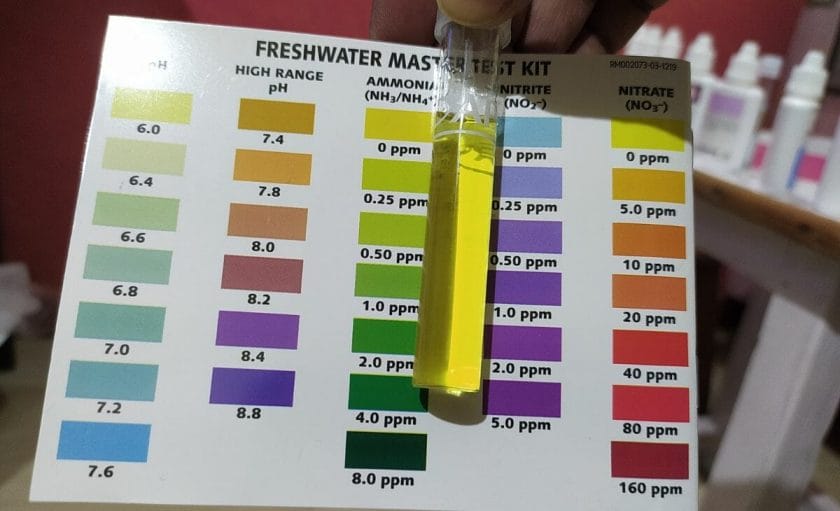
Many new aquarium hobbyists struggle to control ammonia, and they don’t realize what’s causing their tank’s chemical profile to destabilize.
High ammonia is often caused by overstocking, in which case you might need to rehome some of your fish, split the fish into different tanks, or transfer the fish to a larger, more suitably sized tank.
Other causes of ammonia spikes include the following:
- Lack of beneficial bacteria
- Overfeeding
- Poor tank maintenance
Upon seeing that your ammonia levels are too high, your first step should be to do a 50% water change, removing all dead plant matter, dead fish, and waste during the process.
If you notice there’s always leftover food on your tank floor, cut back on feeding to reduce ammonia spikes. It may also be prudent to check your filter media for blockages. Remove any obstructions from your filter to allow the beneficial bacteria to function properly.
Keep a regular schedule of partial water changes and monitor your tank’s progress, and your ammonia levels should drop over time.
FAQs
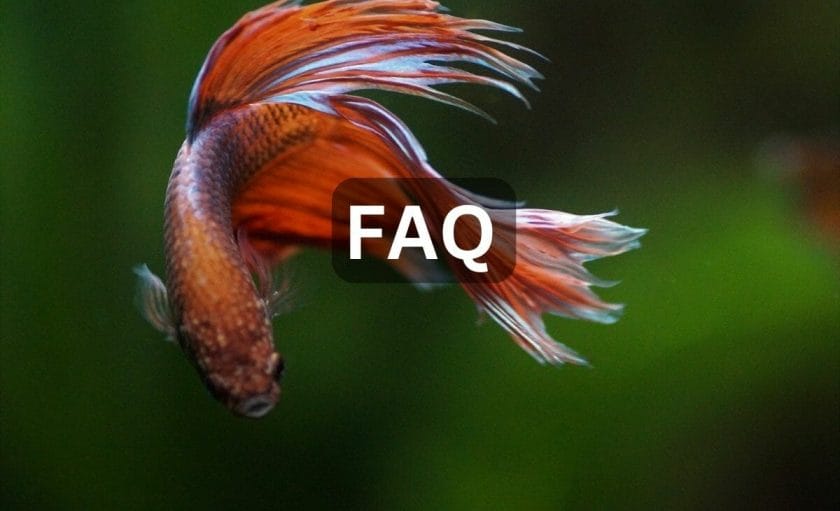
How Do You Transition a Fish to New Water?
It’s important to introduce fish to new water instead of just dumping them in. To do so, float the bag in the water for 15 minutes, after which you can pour a ½ cup of aquarium water into the bag every 5 minutes.
Repeat until the bag is full, dilute the solution by half, and fill the bag again. Once done, the fish can safely be introduced to the tank.
Do I Need to Cycle My Tank before Adding Fish?
In an ideal world, you should cycle your tank before adding fish. Doing so allows the nitrogen cycle to take place, zeroing out harmful ammonia and nitrites before the fish are introduced to a new environment.
Fish already experience a lot of stress going from a store to your home, which is why you should ideally cycle your tank before adding fish.
How Long Should You Wait Before Introducing Another Species of Fish?
Wait 5-6 weeks before you add another species of fish to your tank. Doing so allows any parasites or diseases that may be present in your first batch of fish to present themselves, allowing you to course correct and take action to prevent other fish from being negatively affected.
Conclusion
To keep your fish healthy and happy, wait until the tank is completely cycled before adding new fish.
Avoid introducing too many fish at once and be sure to test regularly to catch ammonia spikes early.
I hope this helpful guide gives your fish a good start in their new home!
You can introduce fish within 24 hours of setting up your tank using the helpful info above, but it’s better to wait 4-6 weeks to cycle the tank first.
In either case, check out the helpful steps in the article above to introduce your new fish safely into the tank!